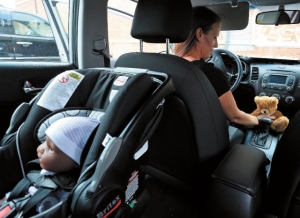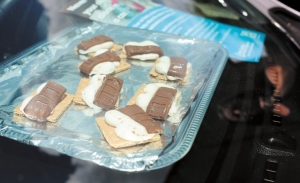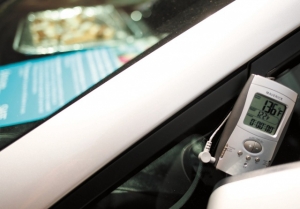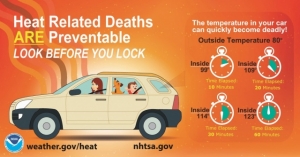Safe Kids program warns of dangers as temperatures increase
By Phyllis Moore
Published in News on July 13, 2017 5:50 AM

News-Argus/CASEY MOZINGO
Safe Kids coordinator Shelly Willis sits a teddy bear in the front of a car Wednesday at Partnership for Children to demonstrate a technique she suggests to not accidentally leave a child in a hot car. Leaving a teddy bear or other item in a car seat and then bringing it to the front of the car will remind the driver or another passenger that the child is in the car with them.

News-Argus/CASEY MOZINGO
S'mores melt in a Safe Kids display on the dashboard of a car at Partnership for Children Wednesday. The temperature in the car was over 135 degrees at the time of the photograph.

News-Argus/CASEY MOZINGO
A special thermometer that registers the inside temperature of a car reads a temperature of 136 degrees around 1 o'clock Wednesday afternoon in the parking lot of Partnership for Children.

Submitted photo
At 11:30 a.m. Wednesday, the thermometer outside read 91 degrees.
Shelly Willis, coordinator of the Safe Kids program at the Partnership for Children, set up a tray of s'mores -- a graham cracker topped with a marshmallow and piece of chocolate -- on the dashboard of a car in their parking lot.
By 1:15 p.m., the chocolate bar had melted and the marshmallows had swelled into a soft consistency.
An oven thermometer, affixed to the partially opened driver window, read 136 degrees.
The demonstration worked out well for dessert lovers in her office, she said. Not so much for human beings who might have found themselves in the vehicle.
As temperatures climb to record highs, she said, there is one rule of thumb, and only one, for leaving children or pets in a hot car -- don't do it.
There has already been one "hot car death" in North Carolina this year, on July 1, in Mooresville, Mrs. Willis said.
"It's definitely not new," she says of the issue that continues to make news.
This year alone, she pointed out, there have already been 19 such deaths nationwide, compared to 39 for 2016.
There are many different scenarios that preclude such incidents -- such as a change of routine or the person behind the wheel.
New parents are already sleep-deprived and adjusting to having a little one in their care. Couple that with not being used to dropping off the child, a sleeping baby, or the required backward-facing car seat.
These are just some of the situations Mrs. Willis hears about, since most of the hot car deaths involve the very youngest segment.
"A lot of times you find it with the rear-facing child, a lot of times it's babies because they're quiet for the most part," she says. "I hear more times, and I'm not blaming the father, but they're not part of that daily routine, when they have to take that child to an appointment or to day care and it's not part of their daily routine."
The same holds true of anyone not generally tasked with that responsibility -- grandparents or other relatives, baby-sitters or teens.
It's a message Mrs. Willis shares often, whether it's a parent attending a Partnership program or during instruction at a car seat safety demonstration.
"When we talk about this with families, we say, never leave a child alone in a vehicle anytime," she said.
This holds true no matter the situation or location, she points out.
"Of course there's always intentionality," she said. "The parent leaves them to run into a store for a few minutes. They see a friend they haven't seen in months. Five minutes turns into 10 minutes and then you've got a child in distress in that vehicle."
The bottom line is education and awareness -- cars heat up quickly.
"On average the inside of a vehicle can heat up about 19 degrees in 10 minutes," she said. "So in 20 minutes it can heat up to 29 degrees and goes up from there. On an 80-degree day it can be 99 degrees inside of the vehicle in 10 minutes and goes up from there."
Unfortunately, there will always be those who simply don't know or naively believe it will never happen to them.
That's a concept Safe Kids hopes to change.
"I would like for the public to know that it can happen to anyone. People are very quick to say, 'That's a horrible parent,'" she said. "We raise this awareness with every car seat safety session we do.
"Don't judge parents. Be aware."
Sometimes, though, it can happen in their own driveway.
"Keep vehicle doors locked at all times, because children play," Mrs. Willis said. "They get inside vehicles. There are automatic windows and doors and child safety locks and they're trapped.
"In those situations, if you can't find your child, check swimming pools or the vehicle first."
Another potential hazard is those quick stops at the gas station, where the parent is technically close by but the child is left inside the vehicle while they pump fuel or go inside to pay.
"It takes seconds for someone to steal that vehicle," she said. "Take measures ahead of time -- keep them safe the entire time they're in that vehicle."
She offered several tips to avoid problems with inadvertently leaving a child in a car.
"I know this sounds strange, but put a cellphone or a shoe or your purse in the back seat, something you always have with you, whereas you may not always have the child with you," she said. "It gets you into the practice of knowing they're in the back seat.
"Another really good thing we recommend is having a stuffed animal in the car seat. Move it to the front seat when you put the baby in there. It's a visual reminder that the child's in the car seat."
Technology is also addressing the situation, she said, with such products as sensors and apps being developed to help remind parents to be vigilant about that small child in the car.
Heightened awareness on this subject is not only pertinent to parents and caregivers. It can also be useful to those who happen upon a potential situation that needs attention.
"People often ask, what do I do if I see a child in a car?" Mrs. Willis said. "Look in vehicles when you're walking through a parking lot. If you see a child in the vehicle, if you see a pet in the vehicle, dial 9-1-1.
"I can't tell you to break somebody's window. By all means do what you feel you can do to make that child safe. Do whatever you can do. Stay there until help arrives. There have been bystanders who have pulled children from vehicles and unfortunately, it's been too late."
